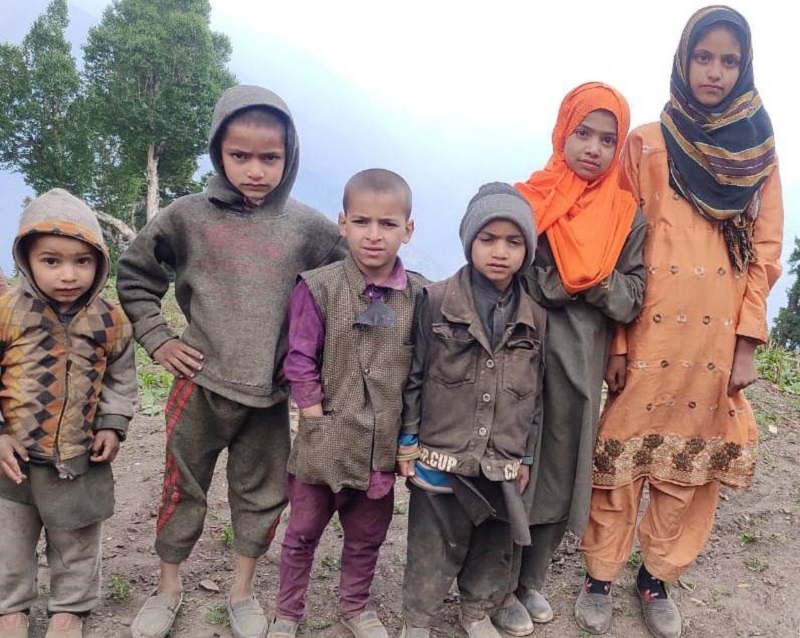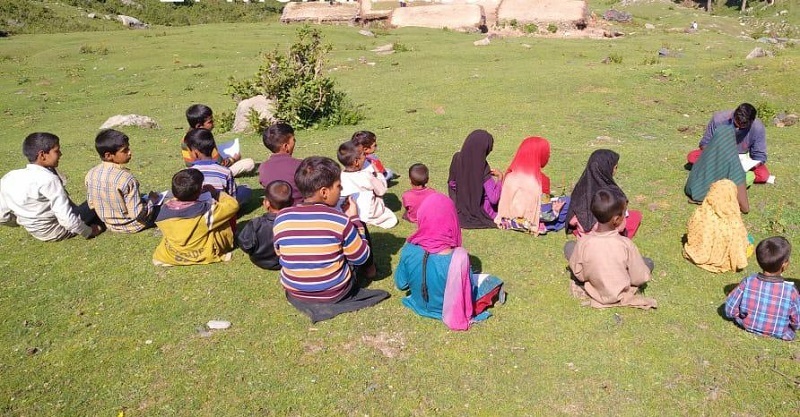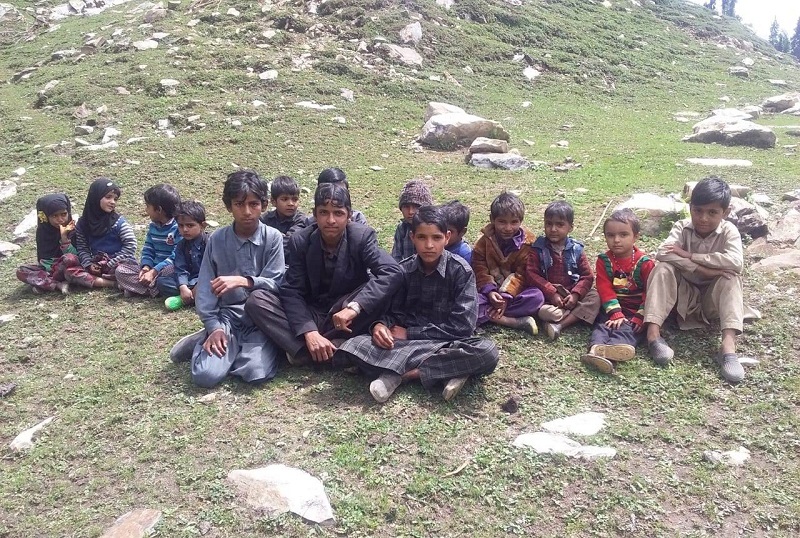
Even as the curb-stricken campuses have resumed their classwork in Kashmir, those living on mountains and meadows are still following the rugged routine that kept them going in the last three lockdown years.
By Umer Ahmad
AT the break of day, Mohammad Ramzan comes out on a mountain mission.
Rambling through a nippy air of peaks dotted with pines and shacks, the athletic man scales heights with an effortless ease, and starts knocking on the tribal doors for taking their children out.
Soon trailed by an army of ‘early birds’—some smiling, some sulking over the snapped sleep—the seasonal school teacher assembles them in the meadow atop mountains for the open-air classes.
Since the abrogation of Article 370 in August 2019 and the ensuing twin Covid lockdowns, these children are mostly out of school. Even as the online classes were floated as an alternative to disrupted classes, these unprivileged students—bereft of smartphones and mobile connectivity—couldn’t attend the pandemic tutorials.
As per the 2011 census, Kashmir houses 11.1 per cent tribal population with 3.7 per cent literacy rate.

This year, Ramzan is working in the picturesque landscape of Tosamaidan in central Kashmir’s Budgam district. Before his teaching outings, the meadow would explode with shells. But now, as the guns have fallen silent in the erstwhile firing range, the likes of Ramzan are slogging to educate and empower the tribal children.
“We’re doing this on our own, without getting any support from the education department,” Ramzan says as he disciplines a bunch of giggling kids. “There’s no accommodation where we can start seasonal classes.”
Every summer the tribals move as gypsies from Jammu region towards the Kashmir valley with livestock. They also bring their children with them and engage them in the livestock rearing.
To make education of the tribal children easy, government of India came up with Samagra. As per the scheme, tribal children can resume their education anywhere they go during their summer migrations. Teachers from the local community are engaged seasonally for the job. They’re to be provided with all the necessary logistic support to run the seasonal schools. “But except a tent in 2007,” Ramzan says, “I’ve received no support from the department.”
Such hitches make Javid Iqbal, President All Jammu and Kashmir Seasonal Teachers Association, reckon that the scheme is scam-infested.
“Even though there’re funds available under Samagra, hardly 10 per cent of that reaches to the ground,” Iqbal says.

In Tosamaidan area, some 25 seasonal teachers attend to 300 students, but “lack of classroom facilities” force parents to keep their wards at home.
“We conduct open-air classes despite harsh weather here,” says Mohammad Iqbal, another seasonal teacher from Tosamaidan.
“When it rains we’ve to let children go. And during the clear skies, the searing sun gives them sunburn. Had we been provided any temporary shelter, it would’ve been easy to run the classes smoothly.”
However, to teach the tribal kids, these seasonal teachers have rented a private Kotha—a wooden hut—of a shepherd and are paying the rent from their own pocket.
“Tosamaidan is far away from our homes and it’s not possible to come and forth every day,” Iqbal says. “So we come here for a month—bringing all the logistics, including ration and other basic necessity.”
While Iqbal points out the painstaking efforts behind the open-air classrooms atop mountains and meadows of the valley, Ramzan plays a ramrod to make his class result-oriented.
But despite plodding on the peaks amid sun and shower, the seasonal teacher takes home a meagre monthly salary of Rs 4,000.
“After joining the department some 15 years ago with the hope that I’ll get regularised in few years, there seems no hope for me now,” the teacher rues.
“Besides salary, study material and stationary for the tribal children has equally become an uphill task for me.”

In Kashmir, the education department has engaged 1747 seasonal teachers. Many of them express disappointment over the trivial job remuneration as well as the telling treatment towards them from their parent department. Among them is Kaneez Parveen.
Since 2015, Kaneez — the 29-year-old Vice President of All Jammu and Kashmir Seasonal Teachers Association — is working as a seasonal teacher in DH Pora, Kulgam.
“This year after organizing many protests, I managed to get reading material for the students,” Kaneez says.
“Even as the department provided just two copies and a pencil to each tribal student, I believe something is better than nothing. Being a member of the Gujjar community myself, I can totally understand my tribe’s ordeal. They can’t afford smartphones and online education and therefore I’m playing my part to empower them through education.”
Kaneez teaches tribal kids in the forests, some 13 kilometres away from her home. Previously, she says, she was deputed to faraway places where the risk of man-wild conflict was high.
“We risk our lives by coming to these wild places,” Kaneez says. “One of our colleagues was attacked by a bear a few days ago when he was going back home after classes. He was lucky as his cries were heard by some nearby shepherds. But sadly, our department didn’t come forward for his treatment. He’s bearing all the expenses himself.”
Despite this disparity, Ramzan says, the department conducts monthly surprise visits to check if teachers are attending their duties. Each visit, he says, comes at the cost of Rs 60,000.
“Rather than spending such hefty amount on those leisure trips, the department could’ve helped these lesser-fortunate children by buying stationery and other basic necessity for them,” the seasonal teacher says.

This apathetic treatment persists despite seasonal teachers continuing their jobs in far-off places even after the abrogation of Article 370, when all the educational institutes were shut across Kashmir.
Performing his duty with the same sense of commitment in Lomarg Lopara, in the Dacchan area of district Kishtwar, Salim Ahmad, 32, embarks on the two-day foot journey to reach the pastoral area where his students keep waiting for him every summer.
“I’m teaching 34 students in Lomarg and getting Rs 4,000 monthly salary for it,” Salim says.
“For a seasonal teacher with 13 years of active service experience, this feels a clear case of exploitation, but then I feel it’s my moral obligation to serve my community. At the end of the day, the system might have disappointed the teacher, but he can’t disappoint his students.”
Follow this link to join our WhatsApp group: Join Now
Be Part of Quality Journalism |
Quality journalism takes a lot of time, money and hard work to produce and despite all the hardships we still do it. Our reporters and editors are working overtime in Kashmir and beyond to cover what you care about, break big stories, and expose injustices that can change lives. Today more people are reading Kashmir Observer than ever, but only a handful are paying while advertising revenues are falling fast. |
| ACT NOW |
| MONTHLY | Rs 100 | |
| YEARLY | Rs 1000 | |
| LIFETIME | Rs 10000 | |










